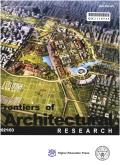使用单块或几块瓷砖在平面上创建 3D 纹理细分图案
IF 3.1
1区 艺术学
0 ARCHITECTURE
引用次数: 0
摘要
在建筑设计中,通过重复少量的元素来创造出具有视觉冲击力的表面,一直以来都在广泛使用镶嵌法。在过去的 2000 年中,人们对二维瓷砖进行了广泛的研究,而本研究的重点是系统地开发一种技术,利用相同的瓷砖模块化地建造具有三维纹理表面的二维瓷砖。本研究使用 Grasshopper 脚本进行参数化几何建模,通过重复单块或几块不同的瓷砖,在平面上生成各种三维浮雕。根据这项研究的结果,可以将具有相同三维纹理表面的瓦片排列成多种配置,从而在棋盘格表面上生成一系列三维浮雕,这些浮雕在相邻瓦片之间表现出平滑的过渡。这项技术的一个重要应用是使用相同的模块制作出令人惊叹的外墙和其他三维表面,通过重复提供经济实惠的模块化建筑。这项研究还展示了该技术的多功能性,利用三角形、正方形、六角形甚至不规则瓷砖制作出各种极具吸引力的非周期性三维表面。本文章由计算机程序翻译,如有差异,请以英文原文为准。
Creating 3D texture tessellation on planar surface using a single tile or a few tiles
Tessellations have been widely used in architectural designs to create visually striking surfaces by repeating a small number of elements. While there has been extensive research on 2D tiling over the past 2000 years, this study focuses on the systematic development of a technique for the modular construction of 2D tiling with 3D texture surfaces using identical tiles, which is of great importance in architectural designs for cost-effective constructions through the mass production of repeating components. This study applies parametric geometrical modelling using Grasshopper scripting to generate a wide range of 3D reliefs on planar surfaces by repeating a single tile or a few different tiles. Based on the findings of this study, it is possible to arrange tiles with an identical 3D texture surface in multiple configurations, resulting in a range of 3D reliefs on tessellated surfaces that exhibit smooth transitions across adjacent tiles. A significant application of this technique is in producing stunning facades and other 3D surfaces using identical modules, offering affordable modular construction through repetition. The study also demonstrates the versatility of the technique by creating various attractive non-periodic 3D surfaces using triangular, square, hexagonal, or even non-regular tiles.
求助全文
通过发布文献求助,成功后即可免费获取论文全文。
去求助
来源期刊

Frontiers of Architectural Research
ARCHITECTURE-
CiteScore
6.20
自引率
2.90%
发文量
430
审稿时长
30 weeks
期刊介绍:
Frontiers of Architectural Research is an international journal that publishes original research papers, review articles, and case studies to promote rapid communication and exchange among scholars, architects, and engineers. This journal introduces and reviews significant and pioneering achievements in the field of architecture research. Subject areas include the primary branches of architecture, such as architectural design and theory, architectural science and technology, urban planning, landscaping architecture, existing building renovation, and architectural heritage conservation. The journal encourages studies based on a rigorous scientific approach and state-of-the-art technology. All published papers reflect original research works and basic theories, models, computing, and design in architecture. High-quality papers addressing the social aspects of architecture are also welcome. This journal is strictly peer-reviewed and accepts only original manuscripts submitted in English.
 求助内容:
求助内容: 应助结果提醒方式:
应助结果提醒方式:


